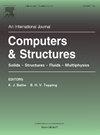An ALE-CR formulation for nonlinear dynamics of 2D variable-length beam with unprescribed moving boundaries
IF 4.8
2区 工程技术
Q1 COMPUTER SCIENCE, INTERDISCIPLINARY APPLICATIONS
引用次数: 0
Abstract
Conventional corotational (CR) beam formulations predominantly employ the Lagrangian description, which is inefficient in addressing moving boundaries. This study proposes a two-dimensional (2D) corotational formulation based on the arbitrary Lagrangian–Eulerian (ALE) description for the nonlinear dynamic analysis of beams with both prescribed and unprescribed moving boundaries. In the corotational framework, the length of the beam element is integrated into the local variables while the material coordinates of the nodes are incorporated into the global variables to describe the unprescribed material flow. Consequently, moving boundaries can be described accurately through moving nodes. An intermediate configuration is introduced to separate the material flow from the Lagrangian motion. The virtual work principle is used to derive the motion equations of the beam. The internal and inertial terms of the element, including those associated with material coordinates, are derived explicitly so that Gaussian quadrature is not required. The configurational force on the unprescribed moving boundary is effectively taken into account, which significantly influences the beam’s axial sliding behavior. The accuracy and efficiency are validated through examples involving moving loads, moving masses and moving supports. It shows the proposed ALE-CR beam formulation is capable of handling both prescribed and unprescribed moving boundaries.
非规定移动边界的二维变长梁非线性动力学的ALE-CR公式
传统的同轴(CR)光束公式主要采用拉格朗日描述,这是低效的处理移动边界。本文提出了一种基于任意拉格朗日-欧拉(ALE)描述的二维(2D)旋转公式,用于具有规定和非规定移动边界的梁的非线性动力分析。在旋转框架中,将梁单元的长度纳入局部变量,将节点的材料坐标纳入全局变量,以描述非规定的材料流。因此,通过移动节点可以准确地描述移动边界。引入了一种中间形态将物质流与拉格朗日运动分离开来。利用虚功原理推导了梁的运动方程。单元的内部项和惯性项,包括与材料坐标相关的项,都被明确地推导出来,因此不需要高斯正交。该方法有效地考虑了非规定移动边界上的构形力,对梁的轴向滑动性能有重要影响。通过动载荷、动质量和动支承的算例验证了该方法的准确性和有效性。结果表明,提出的ALE-CR梁公式能够处理规定和非规定的移动边界。
本文章由计算机程序翻译,如有差异,请以英文原文为准。
求助全文
约1分钟内获得全文
求助全文
来源期刊

Computers & Structures
工程技术-工程:土木
CiteScore
8.80
自引率
6.40%
发文量
122
审稿时长
33 days
期刊介绍:
Computers & Structures publishes advances in the development and use of computational methods for the solution of problems in engineering and the sciences. The range of appropriate contributions is wide, and includes papers on establishing appropriate mathematical models and their numerical solution in all areas of mechanics. The journal also includes articles that present a substantial review of a field in the topics of the journal.
 求助内容:
求助内容: 应助结果提醒方式:
应助结果提醒方式:


